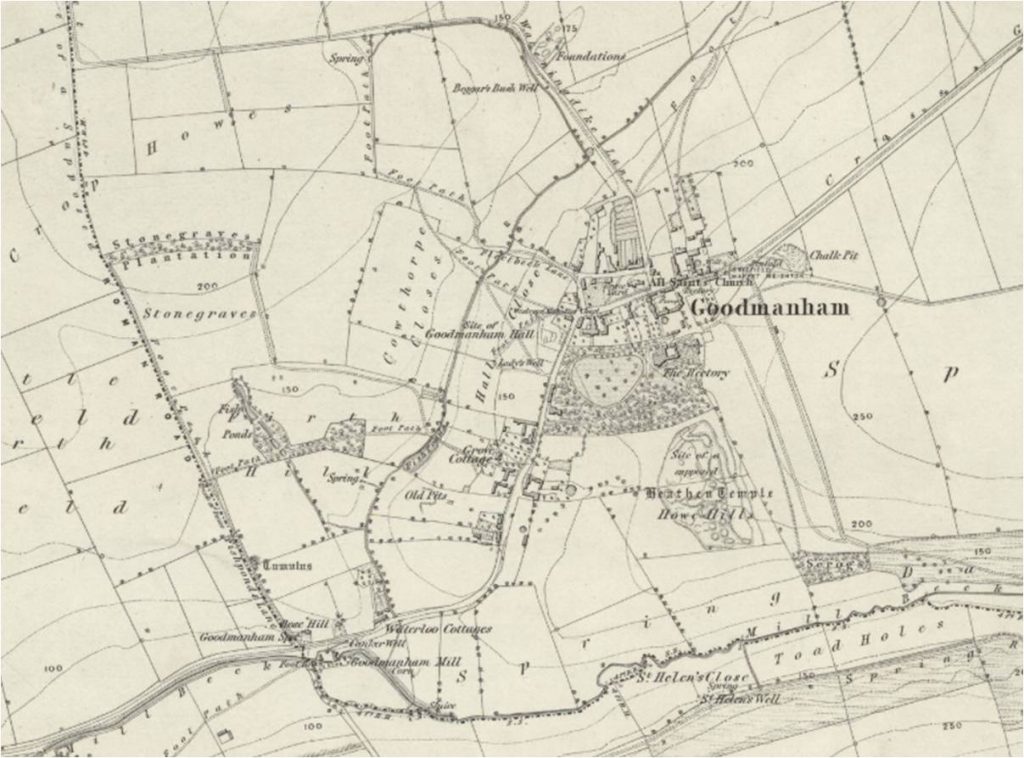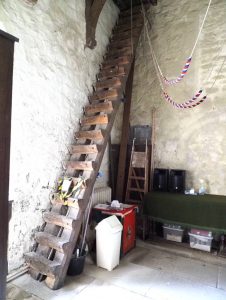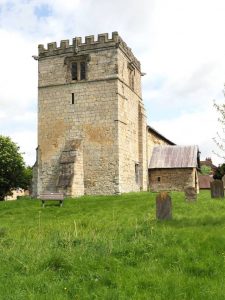The parish of Goodmanham is situated in what was once the wapentake of Hartill, Holme Beacon division, part of the historical East Riding of Yorkshire (see maps in Introduction). It had no recorded sub-parishes before the 1832 parish boundary changes.

The village lies on a fertile, south-facing slope of the Yorkshire Wolds which has been settled since the Stone Age. It dominates the confluence of Mastill Spring and Mill Beck, not far from where Ermine Street followed its nearly straight course between Brough and Londesborough. Ancient burial sites and Roman coins and pottery have been found in the same area. This possibly led some historians to locate the Roman station of Delgovicia at Goodmanham, but others contend that the original Delw Kocdh, meaning “wood of the idols”, was situated at Market Weighton or Londesborough, or even as far as Millington, Malton or Wetwang.
What is not in doubt is that a pagan temple was located at Goodmanham, some claiming that it gave its name to the village: Godo (an uncovered sanctuary or temple) plus mynyddig (a hilly place). Others give the name a more prosaic origin: the home of the people of Godmund. The site of the temple is also disputed, some placing it on Howe Hills that lie to the south of the present church which is said to have been built from its ruins, while others say that the church was built on its ruins. Later excavation established that the “hills” were vestiges of old chalk or lime pits, and the boundaries of the village were found to lie along the lines of ancient earthworks, suggesting a former place of worship of large proportions.
According to Bede, Pope Gregory I sent a Roman missionary to England to convert the pagan Anglo-Saxons to Christianity. The missionary’s name was Paulinus and, after fulfilling his mission in Kent, in 625 he accompanied Æthelburg of Kent to Northumbria to marry Edwin who was king of that vast territory. A condition of the marriage was that Edwin would allow Æthelburg to remain a Christian. Paulinus, pursuing his mission in the north, succeeded in converting Edwin to Christianity in 627, along with many of his subjects. The king’s pagan high priest Coifi was so enthused by the new religion that he mounted a stallion and took up a spear – both proscribed for a man of his calling – and galloped to the great temple of Northumbria, cast his spear into it and ordered his companions to burn it to the ground. Bede describes the location of this momentous event as “not far from York, to the eastward, beyond the river Derwent, now called Godmundinghan”. The destruction of the temple is recorded in a stained glass window in Goodmanham church.
Goodmanham on the eve of the Conquest was made up of four estates, held by Earl Morcar, Kolgrim and Orm, Northmann, and the archbishop of York. All but one were forfeited to the king and his Norman tenants-in-chief (the count of Mortain and William of Percy), with only the archbishop of York retaining his holding. The value of all the estates had decreased drastically by 1086, suggesting that Goodmanham had fallen victim to William I’s Harrying of the North. Thereafter it belonged to the family that took the name Godmandham, but in the mid 1100s passed by the marriage of an heiress to Sir John de Grimston. The Grimstons retained it for about six centuries, and Goodmanham became one of their principal residences. It was subsequently held by the Duke of Devonshire and Lord Londesborough was lord of the manor in the second half of the 1800s.
The church of All Hallows is a grade I listed building. The official list entry states that it stands “almost certainly on the site of a pagan temple” and another source claims that the hill is artificial. Several sources state that the church still retains elements of Anglo-Saxon architecture, without specifying their location, but all agree that the nave and the north aisle date from not before the 12th century. These two features are separated by three massive circular arches, and the nave contains a ladder to the ringing chamber which dates from the same period. The lower part of the tower is also Norman, the distinctive decoration of its former doorway being just visible behind a buttress. The upper part of the tower, with its crenellated parapet and gargoyles, is from a later period. The chancel is 13th century with a highly ornamented Norman arch, but its interior is ceiled so that all trace of its ancient work is hidden. There are two fonts: one plain and hexagonal, probably 12th century, and damaged from being removed to a farmyard when it was replaced by the heavily ornamented, octagonal one dating from the 16th century.
 1st right: 12th and 16th century fonts, 2024 2nd right: Norman chancel arch 3rd right: 12th century ladder – © Jeff Guy, 2023 |  |  |  |
The life events of a number of Puckerings of Goodmanham (8th and 9th generation) were celebrated in the church of Goodmanham.
Sources:
https://www.genuki.org.uk/big/eng/YKS/ERY/Goodmanham
https://en.wikipedia.org/wiki/Goodmanham
https://opendomesday.org/place/SE8843/goodmanham
Ecclesiastical History of the English People, book 2, chapter 13, pp. 83-85: http://www.heroofcamelot.com/docs/Bede-Ecclesiastical-History.pdf
Antiquarian Itinerary, vol. 1, (page numbers not given): https://books.google.fr/books?id=yN4DAAAAYAAJ
History and Topography of Yorkshire, vol. 2, York, Ainsty, East Riding, pp. 579-582: https://books.google.fr/books?redir_esc=y&id=unEKAQAAMAAJ
Bulmer’s History, Topography and Directory of East Yorkshire with Hull 1892, pp. 620-622: https://specialcollections.le.ac.uk/digital/collection/p16445coll4/id/324025
Baine’s History, Directory & Gazeteer of the County of York, vol. 2 North and East Ridings 1823, pp. 210-211: https://archive.org/details/historydirector02baingoog/page/210
Topographical Dictionary of Yorkshire, p. 163: https://archive.org/details/atopographicald01langgoog/page/163
https://web.archive.org/web/20120717011834/http://www.wicstun.com/goodman.html
Church of All Hallows: https://historicengland.org.uk/listing/the-list/list-entry/1084132?section=official-list-entry




